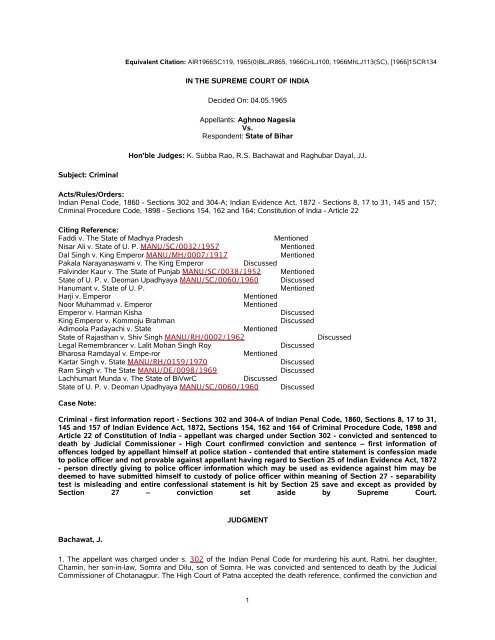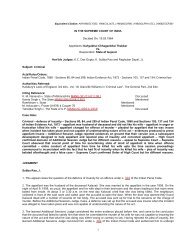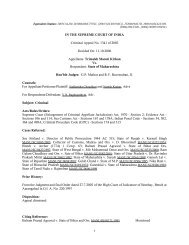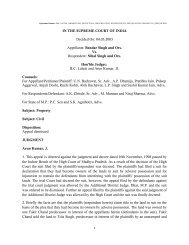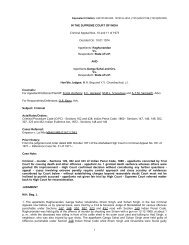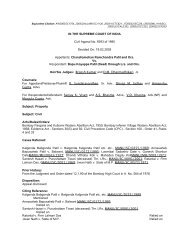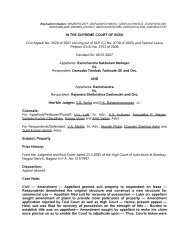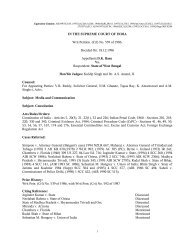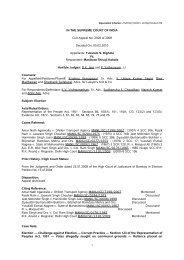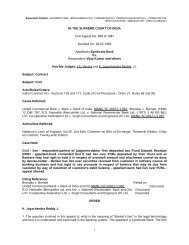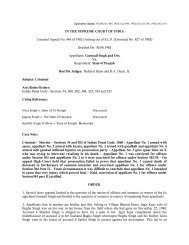IN THE SUPREME COURT OF INDIA Decided On - Judicial ...
IN THE SUPREME COURT OF INDIA Decided On - Judicial ...
IN THE SUPREME COURT OF INDIA Decided On - Judicial ...
You also want an ePaper? Increase the reach of your titles
YUMPU automatically turns print PDFs into web optimized ePapers that Google loves.
Subject: Criminal<br />
Equivalent Citation: AIR1966SC119, 1965(0)BLJR865, 1966CriLJ100, 1966MhLJ113(SC), [1966]1SCR134<br />
<strong>IN</strong> <strong>THE</strong> <strong>SUPREME</strong> <strong>COURT</strong> <strong>OF</strong> <strong>IN</strong>DIA<br />
<strong>Decided</strong> <strong>On</strong>: 04.05.1965<br />
Appellants: Aghnoo Nagesia<br />
Vs.<br />
Respondent: State of Bihar<br />
Hon'ble Judges: K. Subba Rao, R.S. Bachawat and Raghubar Dayal, JJ.<br />
Acts/Rules/Orders:<br />
Indian Penal Code, 1860 - Sections 302 and 304-A; Indian Evidence Act, 1872 - Sections 8, 17 to 31, 145 and 157;<br />
Criminal Procedure Code, 1898 - Sections 154, 162 and 164; Constitution of India - Article 22<br />
Citing Reference:<br />
Faddi v. The State of Madhya Pradesh Mentioned<br />
Nisar Ali v. State of U. P. MANU/SC/0032/1957 Mentioned<br />
Dal Singh v. King Emperor MANU/MH/0007/1917 Mentioned<br />
Pakala Narayanaswami v. The King Emperor Discussed<br />
Palvinder Kaur v. The State of Punjab MANU/SC/0038/1952 Mentioned<br />
State of U. P. v. Deoman Upadhyaya MANU/SC/0060/1960 Discussed<br />
Hanumant v. State of U. P. Mentioned<br />
Harji v. Emperor Mentioned<br />
Noor Muhammad v. Emperor Mentioned<br />
Emperor v. Harman Kisha Discussed<br />
King Emperor v. Kommoju Brahman Discussed<br />
Adimoola Padayachi v. State Mentioned<br />
State of Rajasthan v. Shiv Singh MANU/RH/0002/1962 Discussed<br />
Legal Remembrancer v. Lalit Mohan Singh Roy Discussed<br />
Bharosa Ramdayal v. Empe-ror Mentioned<br />
Kartar Singh v. State MANU/RH/0159/1970 Discussed<br />
Ram Singh v. The State MANU/DE/0098/1969 Discussed<br />
Lachhumart Munda v. The State of BiVwrC Discussed<br />
State of U. P. v. Deoman Upadhyaya MANU/SC/0060/1960 Discussed<br />
Case Note:<br />
Criminal - first information report - Sections 302 and 304-A of Indian Penal Code, 1860, Sections 8, 17 to 31,<br />
145 and 157 of Indian Evidence Act, 1872, Sections 154, 162 and 164 of Criminal Procedure Code, 1898 and<br />
Article 22 of Constitution of India - appellant was charged under Section 302 - convicted and sentenced to<br />
death by <strong>Judicial</strong> Commissioner - High Court confirmed conviction and sentence – first information of<br />
offences lodged by appellant himself at police station - contended that entire statement is confession made<br />
to police officer and not provable against appellant having regard to Section 25 of Indian Evidence Act, 1872<br />
- person directly giving to police officer information which may be used as evidence against him may be<br />
deemed to have submitted himself to custody of police officer within meaning of Section 27 - separability<br />
test is misleading and entire confessional statement is hit by Section 25 save and except as provided by<br />
Section 27 – conviction set aside by Supreme Court.<br />
Bachawat, J.<br />
JUDGMENT<br />
1. The appellant was charged under s. 302 of the Indian Penal Code for murdering his aunt, Ratni, her daughter,<br />
Chamin, her son-in-law, Somra and Dilu, son of Somra. He was convicted and sentenced to death by the <strong>Judicial</strong><br />
Commissioner of Chotanagpur. The High Court of Patna accepted the death reference, confirmed the conviction and<br />
1
sentence and dismissed the appeal preferred by the appellant. The appellant now appeals to this Court by special<br />
leave.<br />
2. The prosecution case is that on August 11, 1963 between 7 a.m. and 8 a.m. the appellant murdered Somra in a<br />
forest known as Dungijharan Hills and later Chamin in Kesari Garha field and then Ratni and Dilu in the house of<br />
Ratni at village Jamtoli.<br />
3. The first information of the offences was lodged by the appellant himself at police station Palkot on August 11,<br />
1963 at 3-15 p.m. The information was reduced to writing by the officer-in-charge, Sub- Inspector H. P. Choudhury,<br />
and the appellant affixed his left thumb- impression on the report. The Sub Inspector immediately took cognizance of<br />
the offence, and arrested the appellant. The next day, the Sub Inspector in the company of the appellant went to the<br />
house of Ratni, where the appellant pointed out the dead bodies of Ratni and Dilu and also a place in the orchard of<br />
Ratni covered with bushes and grass, where he had concealed a tangi. The appellant then took the Sub Inspector<br />
and witnesses to Kasiari garha khet and pointed out the dead body of Chamin lying in a ditch covered with Ghunghu.<br />
The appellant then took the Sub Inspector and the witnesses to Dungijharan Hills, where he pointed out the dead<br />
body of Somra lying in the slope of the hills to the north. The Sub Inspector also recovered from the appellant's house<br />
a chadar stained with human blood. The evidence of P.W. 6 shows that the appellant had gone to the forest on the<br />
morning of August 11, 1963.<br />
4. The medical evidence discloses incised wounds on all the dead bodies. The injuries were caused by a sharpcutting<br />
weapon such as a tangi. All the four persons were brutally murdered.<br />
5. There is no eye-witness to the murders. The principal evidence against the appellant consists of the first<br />
information report, which contains a full confession of guilt by the appellant. If this report is excluded, the other<br />
evidence on the record is insufficient to convict the appellant. The principal question in the appeal is whether the<br />
statement or any portion of it is admissible in evidence.<br />
6. The first information report reads as follows : "My name is Aghnu Nagesia. (1) My father's name is Lodhi Nagesia. I<br />
am a resident of Lotwa, Tola Jamtoli, Thana Palkot, district Ranchi. Today, Sunday, date not known, at about 3 p.m. I<br />
having come to the P. S. make statement before by the S. I. of Police (2) that on account of my Barima (aunt)<br />
Mussammat having given away her property to her daughter and son-in-law quarrels and troubles have been<br />
occurring among us. My Barima has no son and she is a widow. Hence on her death we shall be owners of her lands<br />
and properties and daughter and son- in-law of Barima shall have no right to them. She lives separate from us, and<br />
lives in her house with her daughter and son-in-law and I live with my brother separately in my house. Our lands are<br />
separate from the time of our father. (3) Today in the morning at about 7-8 a.m. I had gone with a tangi to Duni<br />
Jharan Pahar to cut shrubs for fencing. I found Somra sitting alone there who was grazing cattle there. (4) Seeing him<br />
I got enraged and dealt him a tangi blow on the filli (calf) of right leg, whereby he toppled down on the ground.<br />
Thereupon I dealt him several Chheo (blows) on the head and the face, with the result that he became speechless<br />
and died. At that time there was none near about on that Pahar. (5) Thereafter I came to the Kesar J Garu field where<br />
"Somra's wife Chamin was weeding out grass in the field. (6) I struck her also all on a sudden on the head with the<br />
said tangi whereby she dropped down on the ground and died then and there. (7) Thereafter I dragged her to an<br />
adjoining field and laid her in a ditch to the north of it and covered her body with Gongu (Pala ke Chhata) so that<br />
people might not see her. There was no person then at that place also. (8) Thereafter I armed with that tangi went to<br />
the house of my Barima to kill her. When I reached there, I found that she was sitting near the hearth which was<br />
burning. (9) Reaching there all on a sudden I began to strike her on the head with tangi whereupon she dropped<br />
down dead at that very place. (10) Near her was Somra's son aged about 3-4 years. (11)1 also struck him with the<br />
tangi. He also fell down and died. (12) I finished the line of my Barima so that no one could take share in her<br />
properties. (13) I hid the tangi in the jhari of my Barima's house. (14) Later on I narrated the occurrence to my chacha<br />
(father's brother) Lerha that I killed the aforesaid four persons with tangi. After sometime (15) T started for the P.S. to<br />
lodge information and reaching the P.S. T make this statement before you. (16) My Barima had all along been<br />
quarrelling like a Murukh (foolish woman) and being vexed, I did so. (17) All the dead bodies and the tangi would be<br />
lying in those places. I can point them out. (18) This is my statement. I got it read over to me and finding it correct, I<br />
affixed my left thumb-impression."<br />
7. We have divided the statement into 18 parts. Parts 1, 15 and 18 show that the appellant went to the police station<br />
to make the report. Parts 2 and 16 show his motive for the murders. Parts 3, 5, 8 and 10 disclose the movements and<br />
opportunities of the appellant before the murders. Part 8 also discloses his intention. Parts 4, 6, 9 and 11 disclose<br />
that the appellant killed the four persons. Part 12 discloses the killing and the motive. Parts 7, 13 and 17 disclose<br />
concealment of a dead body and a tangi and his ability to point out places where the dead bodies and the tangi were<br />
lying. Part 14 discloses the previous confession by the appellant. Broadly speaking, the High Court admitted in<br />
evidence parts 1, 2, 3, 5, 7, 8, 10, 13, 15, 16, 17 and 18.<br />
2
8. <strong>On</strong> behalf of the appellant, it is contended that the entire statement is a confession made to a police officer and is<br />
not provable against the appellant, having regard to s. 25 of the Indian Evidence Act, 1872. <strong>On</strong> behalf of the<br />
respondent, it is contended that s. 25 protects only those portions of the statement which disclose the killings by the<br />
appellant and the rest of the statement is not protected by s. 25.<br />
9. Section 25 of the Evidence Act is one of the provisions of law dealing with confessions made by an accused. The<br />
law relating to confessions is to be found generally in ss. 24 to 30 of the Evidence Act and ss. 162 and 164 of the<br />
Code of Criminal Procedure, 1898. Sections 17 to 31 of the Evidence Act are to be found under the heading<br />
"Admissions". Confession is a species of admission, and is dealt with in ss. 24 to 30. A confession or an admission<br />
is evidence against the maker of it, unless its admissibility is excluded by some provision of law. Section 24 excludes<br />
confessions caused by certain inducements, threats and promises. Section 25 provides : "No confession made to a<br />
police officer, shall be proved as against a person accused of an offence." The terms of s. 25 are imperative. A<br />
confession made to a police officer under any circumstances is not admissible in evidence against the accused. It<br />
covers a confession made when he was free and not in police custody, as also a confession made before any<br />
investigation has begun. The expression "accused of any offence" covers a person accused of an offence at the trial<br />
whether or not he was accused of the offence when he made the confession. Section 26 prohibits proof against any<br />
person of a confession made by him in the custody of a police officer, unless it is made in the immediate presence of<br />
a Magistrate. The partial ban imposed by s, 26 relates to a confession made to a person other than a police officer.<br />
Section 26 does not qualify the absolute ban imposed by s. 25 on a confession made to a police officer. Section 27<br />
is in the form of a proviso, and partially lifts the ban imposed by ss. 24, 25 and 26. It provides that when any fact is<br />
deposed to as discovered in consequence of information received from a person accused of any offence, in the<br />
custody of a police officer, so much of such information, whether it amounts to a confession or not, as relates<br />
distinctly to the fact thereby discovered, may be proved. Section 162 of the Code of Criminal Procedure forbids the<br />
use of any statement made by any person to a police officer in the course of an investigation for any purpose at any<br />
enquiry or trial in respect of the offence under investigation, save as mentioned in the proviso and in cases falling<br />
under sub-s (2), and it specifically provides that nothing in it shall be deemed to affect the provisions of s. 27 of the<br />
Evidence Act. The words of s. 162 are wide enough to include a confession made to a police officer in the course of<br />
an investigation. A statement or confession made in the course of an investigation may be recorded by a Magistrate<br />
under s. 164 of the Code of Criminal Procedure subject to the safeguards imposed by the section. Thus, except as<br />
provided by s. 27 of the Evidence Act, a confession by an accused to a police officer is absolutely protected under s.<br />
25 of the Evidence Act, and if it is made in the course of an investigation, it is also protected by s. 162 of the Code of<br />
Criminal Procedure, and a confession to any other person made by him while in the custody of a police officer is<br />
protected by s. 26, unless it is made in the immediate presence of a Magistrate. These provisions seem to proceed<br />
upon the view that confessions made by an accused to a police officer or made by him while he is in the custody of a<br />
police officer are not to be trusted, and should not be used in evidence against him. They are based upon grounds of<br />
public policy, and the fullest effect should be given to them.<br />
10. Section 154 of the Code of Criminal Procedure provides for the recording of the first information. The information<br />
report as such is not substantive evidence. It may be used to corroborate the informant under s. 157 of the Evidence<br />
Act or to contradict him under s. 145 of the Act, if the informant is called as a witness. If the first information is given<br />
by the accused himself, the fact of his giving the information is admissible against him as evidence of his conduct<br />
under s. 8 of the Evidence Act. If the information is a non- confessional statement, it is admissible against the<br />
accused as an admission under s. 21 of the Evidence Act and is relevant, see Faddi v. The State of Madhya Pradesh<br />
(1) Criminal Appeal No. 210 of 1963 decided on January 24, 1964 explaining Nisar Ali v. State of U. P. (2)<br />
MANU/SC/0032/1957 : 1957CriLJ550 and Dal Singh v. King Emperor L. R. 44 I. A. 137. But a confessional first<br />
information report to a police officer cannot be used against the accused in view of s. 25 of the Evidence Act.<br />
11. The Indian Evidence Act does not define "confession". For a long time, the Courts in India adopted the definition<br />
of "confession" given in Art. 22 of Stephen's Digest of the Law of Evidence. According to that definition, a confession<br />
is an admission made at any time by a person charged with crime, stating or suggesting the inference that he<br />
committed that crime. This definition was discarded by the <strong>Judicial</strong> Committee in Pakala Narayanaswami v. The King<br />
Emperor L.R.[1939] .I. A. 66. Lord Atkin observed :<br />
"........... no statement that contains self-exculpatory matter can amount to confession, if the<br />
exculpatory statement is of some fact which if true would negative the offence alleged to be<br />
confessed. Moreover, a confession must either admit in terms the offence, or at any rate<br />
substantially all the facts which constitute the offence. An admission of a gravely incriminating fact,<br />
even a conclusively incriminating fact, is not of itself a confession, e.g., an admission that the<br />
accused is the owner of and was in recent possession of the knife or revolver which caused a<br />
death with no explanation of any other man's possession."<br />
3
12. These observations received the approval of this Court in Palvinder Kaur v. The State of Punjab<br />
MANU/SC/0038/1952 : 1953CriLJ154 . In State of U. P. v. Deoman Upadhyaya (6) MANU/SC/0060/1960 :<br />
1960CriLJ1504 , Shah, J. referred to a confession as a statement made by a person stating or suggesting the<br />
inference that he has committed a crime.<br />
13. Shortly put, a confession may be defined as an admission of the offence by a person charged with the offence. A<br />
statement which contains self- exculpatory matter cannot amount to a confession, if the exculpatory statement is of<br />
some fact which, if true, would negative the offence alleged to be confessed. If an admission of an accused is to be<br />
used against him, the whole of it should be tendered in evidence, and if part of the admission is exculpatory and part<br />
inculpatory, the prosecution is not at liberty to use in evidence the inculpatory part only. See Hanumant v. State of U.<br />
P. (1) MANU/SC/0037/1952 : 1953CriLJ129 and Palvinder Kaur v. The State of Punjab [1953] S. C 94. The<br />
accused is entitled to insist that the entire admission including the exculpatory part must be tendered in evidence. But<br />
this principle is of no assistance to the accused where no part of his statement is self-exculpatory, and the<br />
prosecution intends to use the whole of the statement against the accused.<br />
14. Now, a confession may consist of several parts and ma reveal not only the actual commission of the crime but<br />
also the motive, the preparation, the opportunity, the provocation, the weapons used, the intention, the concealment<br />
of the weapon and the subsequent conduct of the accused. If the confession is tainted, the taint attaches to each part<br />
of it. It is not permissible in law to separate one part and to admit it in evidence as a non-confessional statement.<br />
Each part discloses some incriminating fact, i.e., some fact which by itself or along with other admitted or proved facts<br />
suggests the inference that the accused committed the crime, and though each part taken singly may not amount to a<br />
confession, each of them being part of a confessional statement partakes of the character of a confession. If a<br />
statement contains an admission of an offence, not only that admission but also every other admission of an<br />
incriminating fact contained in the statement is part of the confession.<br />
15. If proof of the confession is excluded by any provision of law such as s. 24, s. 25 and s. 26 of the Evidence Act,<br />
the entire confessional statement in all its parts including the admissions of minor incriminating facts must also be<br />
excluded, unless proof of it is permitted by some other section such as s. 27 of the Evidence Act. Little substance<br />
and content would be left in ss. 24, 25 and 26 if proof of admissions of incriminating facts in a confessional<br />
statement is permitted.<br />
16. Sometimes, a single sentence in a statement may not amount to a confession at all. Take a case of a person<br />
charged under s. 304-A of the Indian Penal Code and a statement made by him to a police officer that "I was drunk;<br />
I was driving a car at a speed of 80 miles per hour; I could see A on the road at a distance of 80 yards; I did not blow<br />
the horn; I made no attempt to stop the car; the car knocked down A". No single sentence in this statement amounts<br />
to a confession, but the statement read as a whole amounts to a confession of an offence under s. 304-A of the<br />
Indian Penal Code, and it would not be permissible to admit in evidence each sentence separately as a non-<br />
confessional statement. Again, take a case where a single sentence in a statement amounts to an admission of an<br />
offence.'A' states "I struck 'B' with a tangi and hurt him". In consequence of the injury 'B' died.'A' committed an offence<br />
and is chargeable under various sections of the Indian Penal Code. Unless he brings his case within one of the<br />
recognised exceptions, his statement amounts to an admission of an offence, but the other parts of the statement<br />
such as the motive, the preparation, the absence of provocation, concealment of the weapon and the subsequent<br />
conduct, all throw light upon the gravity of the offence and the intention and knowledge of the accused, and negatives<br />
the right of private defence, accident and other possible defences. Each and every admission of an incriminating fact<br />
contained in the confessional statement is part of the confession.<br />
17. If the confession is caused by an inducement, threat or promise as contemplated by s. 24 of the Evidence Act,<br />
the whole of the confession is excluded by s. 24. Proof of not only the admission of the offence but also the<br />
admission of every other incriminating fact such as the motive, the preparation and the subsequent conduct is<br />
excluded by s. 24. To hold that the proof of the admission of other incriminating facts is not barred by s. 24 is to rob<br />
the section of its practical utility and content. It may be suggested that the bar of s. 24 does not apply to the other<br />
admissions, but through receivable in evidence, they are of no weight, as they were caused by inducement, threat or<br />
promise. According to this suggestion, the other admissions are relevant, but are of no value. But we think that on a<br />
plain construction of s. 24, proof of all the admissions of incriminating facts contained in a confessional statement is<br />
excluded by the section. Similarly, ss. 25 and 26 bar not only proof of admissions of an offence by an accused to a<br />
police officer or made by him while in the custody of a police officer but also admissions contained in the confessional<br />
statement of all incriminating facts related to the offence.<br />
18. A little reflection will show that the expression "confession" in ss. 24 to 30 refers to the confessional statement<br />
as a whole including not only the admissions of the offence but also all other admissions of incriminating facts related<br />
to the offence. Section 27 partially lifts the ban imposed by ss. 24, 25 and 26 in respect of so much of the<br />
4
information whether it amounts to a confession or not, as relates distinctly to the fact discovered in consequence of<br />
the information, if the other conditions of the section are satisfied. Section 27 distinctly contemplates that an<br />
information leading to a discovery may be a part of the confession of the accused and thus, fall within the purview of<br />
ss. 24, 25 and 26. Section 27 thus shows that a confessional statement admitting the offence may contain additional<br />
information as part of the confession. Again, s. 30 permits the Court to take into consideration against a co-accused<br />
a confession of another accused affecting not only himself but the other co-accused. Section 30 thus shows that<br />
matters affecting other persons may form part of the confession.<br />
19. If the first information report is given by the accused to a police officer and amounts to a confessional statement,<br />
proof of the confession is prohibited by s. 25. The confession includes not only the admission of the offence but all<br />
other admissions of incriminating facts related to the offence contained in the confessional statement. No part of the<br />
confessional statement is receivable in evidence except to the extent that the ban of s. 25 is lifted by s. 27.<br />
20. Our attention is not drawn to any decision of this Court or of the Privy Council on the question whether apart from<br />
s. 27, a confessional first information report given by an accused is receivable in evidence against him. Decisions of<br />
the High Courts on this point are hopelessly conflicting. They contain all shades of opinion ranging from total<br />
exclusion of the confession to total inclusion of all admissions of incriminating facts except the actual commission of<br />
the crime. In Harji v. Emperor A. I. R. 1918 Lah. 69 and Noor Muhammad v. Emperor [1925] 90 I. C. 148, the Lahore<br />
High Court held that the entire confessional first information report was inadmissible in evidence. In Emperor v.<br />
Harman Kisha I. L. R [1935] Bom. 120, the Bombay High Court held that the entire confessional report dealing with<br />
events on the night of the offence was hit by s. 25, and it could not be said that portions of it dealing with the motive<br />
and the opportunity were not parts of the confession. In King Emperor v. Kommoju Brahman I.L.R. [1940] Pat 301the<br />
Patna High Court held that no part of the confessional first information report was receivable in evidence, the entire<br />
report formed a single connected story and no part o£ it had any meaning or significance except in relation to the<br />
whole, and it would be wrong to extract parts of the statement and treat them as relevant. This case was followed in<br />
Adimoola Padayachi v. State(1960] M.W.N.28, and the Court admitted only the portion of the confessional first<br />
information report which showed it was given by the accused and investigation had started thereon. In State of<br />
Rajasthan v. Shiv Singh , the Court admitted in evidence the last part of the report dealing with the movements of the<br />
accused after the commission of the offence, but excluded the other parts of the statement including those ' relating<br />
to motive and opportunity. In Legal Remembrancer v. Lalit Mohan Singh Roy I.L.R. [1922] Cal. 167, the Calcutta High<br />
Court admitted in evidence the narrative of the events prior to the night of the occurrence disclosing the motive of the<br />
offence. This case was followed by the Nagpur Court in Bharosa Ramdayal v. Empe-ror(4). In Kartar Singh v.<br />
State(5), the Court admitted in evidence the introductory part and the portion narrating the motive and the<br />
opportunity. In Ram Singh v. The State(*), the Rajasthan High Court held that where it is possible to separate parts of<br />
the first information report by an accused from that in which he had made a confession, that part which can be so<br />
separated should be admitted in evidence, and on this view, admitted a part of the report relating to motive and<br />
subsequent conduct including the statement that the accused had left the deceased lying wounded and breathing in<br />
the tibari and there was no hope of her surviving and he had come having covered her with a cloth. In Lachhumart<br />
Munda v. The State of BiVwrC), the Patna High Court admitted in evidence portions of the first information report<br />
relating to the motive, the opportunity and the entire narrative of events before and after the crime. This case was<br />
followed in the judgment! under appeal. Some of the decided cases took the view that if a part of the report is<br />
property severable from the strict confessional part, then the severable part could be tendered in evidence. We think<br />
that the separability test is misleading, and the entire confessional statement is hit by s. 25 and save and except as<br />
provided by s. 27 and save and except the formal part identifying the accused as the maker of the report, no part of it<br />
could be tendered in evidence.<br />
21. We think, therefore, that save and except parts 1, 15 and 18 identifying the appellant as the maker of the first<br />
information report and save and except the portions coming within the purview of s. 27, the entire first information<br />
report must be excluded from evidence.<br />
22. Section 27 applies only to information received from a person accused of an offence in the custody of a police<br />
officer. Now, the Sub Inspector stated that he arrested the appellant after he gave the first information report leading<br />
to the discovery. Prima facie, therefore, the appellant was not in the custody of a police officer when he gave the<br />
report, unless it can be said that he was then in constructive custody. <strong>On</strong> the question whether a person directly<br />
giving to a police officer information which may be used as evidence against him may be deemed to have submitted<br />
himself to the custody of the police officer within the meaning of s. 27, there is conflict of opinion. See the<br />
observations of Shah, J. and Subba Rao, J. in State of U. P. v. Deoman Upadhyaya (1) MANU/SC/0060/1960 :<br />
1960CriLJ1504 . For the purposes of the case, we shall assume that the appellant was constructively in police<br />
custody and therefore the information contained in the first information report leading to the discovery of the dead<br />
bodies and the tangi is admissible in evidence. The entire evidence against the appellant then consists of the fact that<br />
the appellant gave information as to the place where the dead bodies were lying and as to the place where he<br />
concealed the tangi, the discovery of the dead bodies and the tangi in consequence of the information, the discovery<br />
5
of a blood-stained chadar from the appellant's house and the fact that he had gone to Dungi Jharan Hills on the<br />
morning of August U, 1963- This evidence is not sufficient to convict the appellant of the offences under s. 302 of the<br />
Indian Penal Code.<br />
23. In the result, the appeal is allowed, the conviction and sentence passed by the Courts below are set aside, and<br />
the appellant is directed to be set at liberty forthwith.<br />
24. Appeal allowed.<br />
6


